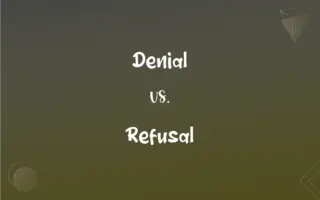With vs. Along With: What's the Difference?
Edited by Aimie Carlson || By Harlon Moss || Updated on December 20, 2023
"With" is used to indicate accompaniment or presence, while "along with" suggests addition or inclusion, often without implying importance or hierarchy.

Key Differences
With is a preposition used to indicate being together or being involved. Along with is also a preposition but often suggests something is being added or included as a supplementary or additional element.
Using with can imply a closer or more integral relationship. Along with might imply that the additional element is secondary or less important.
With is more versatile, used in various contexts like with friends, with interest. Along with is often used where something is being added to a list or group, like along with the main course.
With is more commonly used and is a fundamental part of English grammar. Along with is used less frequently and often in more specific contexts.
With may imply a stronger connection or partnership. Along with often implies a relationship where the additional part is not the primary focus.
ADVERTISEMENT
Comparison Chart
Basic Use
Indicates accompaniment or involvement
Suggests addition or being supplementary
Connotation
Implies a closer or integral relationship
Often implies a secondary addition
Contextual Use
Versatile in various contexts
Used where something is added to a list
Frequency
More commonly used
Less common, more specific contexts
Implication
Stronger connection or partnership
Addition without primary focus
ADVERTISEMENT
With and Along With Definitions
With
Accompanied by or in the company of.
She went to the movies with her friends.
Along With
Accompanying; as a companion or accessory.
The manual, along with the tools, was in the box.
With
Possessing or carrying.
He arrived with a gift in his hand.
Along With
In the course of or during.
He found several interesting items along with his search.
With
Indicating the cause or reason.
He trembled with fear.
Along With
As part of a group or set.
Along with her colleagues, she received an award.
With
Using a particular method or tool.
She cut the paper with scissors.
Along With
In addition to; together with.
He brought his guitar along with his backpack.
With
Indicating the manner or attitude.
They listened with interest.
Along With
Simultaneously or in conjunction with.
The decline in sales occurred along with economic downturns.
With
In the company of; accompanying
Did you go with her?.
With
Next to; alongside of
Stood with the rabbi.
Sat with the family.
FAQs
What does along with mean?
Suggests addition or inclusion.
Does along with imply equal importance?
Not necessarily, it can indicate something is secondary.
What does with mean?
Indicates presence or accompaniment.
Is with used for physical presence only?
No, it's used for both physical and abstract associations.
Which is more common in everyday language?
With is more common and versatile.
Does with show a closer relationship?
It can imply a more integral or close association.
Can with indicate a method?
Yes, as in "cutting with a knife."
Can with and along with be used interchangeably?
In some contexts, but they can convey different nuances.
Is along with used in formal writing?
Yes, especially to add supplementary information.
Can along with introduce a list?
Yes, often to add items to a group or list.
Can along with be used to show time relations?
Yes, as in "occurring along with an event."
How is along with different in tone?
It can sound more formal or specific.
Does along with emphasize the main subject?
No, it often focuses on the additional element.
Is with used for causal relationships?
Yes, like "shaking with cold."
Does along with suggest addition to the main element?
Yes, it often indicates an addition or supplement.
Is with used in idiomatic expressions?
Yes, in many phrases like "with open arms."
How does with function in a sentence?
As a preposition linking nouns to other elements.
Can with be used in emotional contexts?
Yes, like "filled with joy."
Is along with used in everyday conversation?
Less frequently, more in specific or formal contexts.
Can with indicate having something?
Yes, as in "a person with a hat."
About Author
Written by
Harlon MossHarlon is a seasoned quality moderator and accomplished content writer for Difference Wiki. An alumnus of the prestigious University of California, he earned his degree in Computer Science. Leveraging his academic background, Harlon brings a meticulous and informed perspective to his work, ensuring content accuracy and excellence.
Edited by
Aimie CarlsonAimie Carlson, holding a master's degree in English literature, is a fervent English language enthusiast. She lends her writing talents to Difference Wiki, a prominent website that specializes in comparisons, offering readers insightful analyses that both captivate and inform.






































































